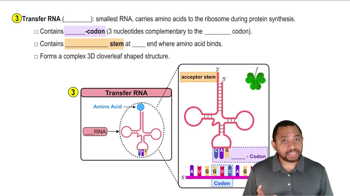Textbook Question
Match the following statements with rRNA, mRNA, or tRNA:
b. brings amino acids to the ribosomes for protein synthesis
613
views
 Verified step by step guidance
Verified step by step guidance Verified video answer for a similar problem:
Verified video answer for a similar problem:



 2:43m
2:43mMaster Types of RNA Concept 1 with a bite sized video explanation from Jules
Start learning